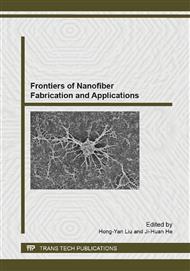[1]
D. Chen, T.X. Liu, X.P. Zhou, W.C. Tjiu, H.Q. Hou. Electrospinning Fabrication of High Strength and Toughness Polyimide Nanofiber Membranes Containing Multiwalled Carbon Nanotubes, J. Phys. Chem. 29 (2009) 9741-9748.
DOI: 10.1021/jp9025128
Google Scholar
[2]
P.P. Tsai, J.R. Roth, W.W. Chen. Strength, Surface Energy, and Ageing of Meltblown and Electrospun Nylon and Polyurethane (PU) Fabrics Treated by a One Atmosphere Uniform Glow Discharge Plasma (OAUGDP™), Text Res J. 12 (2005) 819-825.
DOI: 10.1177/0040517505057526
Google Scholar
[3]
J.P. Tessonnier, L. Pesant, C. Pham-Huu, G. Ehret, M.J. Ledoux. Carbon nanotubes: a highly selective support for the C=C hydrogenation reaction, Stud. Surf. Sci. Catal. 143(2002) 697-704.
DOI: 10.1016/s0167-2991(00)80712-0
Google Scholar
[4]
Q. Ngo, B.A. Cruden, A.M. Cassell, G. Sims, M. Meyyappan, J. Li, C. Y. Yang. Thermal Interface Properties of Cu-filled Vertically Aligned Carbon Nanofiber Arrays, Nano Lett. 12 (2004) 2403-2407.
DOI: 10.1021/nl048506t
Google Scholar
[5]
L.X. He, S.C. Tjong. Nonlinear electrical conduction in percolating systems induced by internal field emission, J. Nanosci. Nanotechno.5 (2011) 3916-3921.
DOI: 10.1016/j.synthmet.2010.12.007
Google Scholar
[6]
J.H. He, Effect of temperature on surface tension of a bubble and hierarchical ruptured bubbles for nanofiber fabrication, Therm. Sci., 16(2012)325-328.
DOI: 10.2298/tsci111111033h
Google Scholar
[7]
J.H. He, Y. Liu, L. Xu, et al. BioMimic fabrication of electrospun nanofibres with high-throughput, Chaos Soliton. Fract., 37(2008) 643-651.
DOI: 10.1016/j.chaos.2007.11.028
Google Scholar
[8]
Y. Liu, J.H. He, L. Xu, et al. The principle of bubble electrospinning and its experimental verification, J. Polym. Eng., 28(2008) 55-65.
Google Scholar
[9]
J.H. He , Y. Liu , L. Xu, Apparatus for preparing electrospun nanofibres: a comparative review , Mater. Sci. Tech., 26(2010)1275-1287.
DOI: 10.1179/026708310x12798718274430
Google Scholar
[10]
R.R. Yang, J.H. He , J.Y. Yu, et al., Bubble-electrospinning for Fabrication of Nanofibres with Diameter of about 20nm, Int. J. Nonlin. Sci. Num., 11(2010)163-164.
Google Scholar
[11]
J.H. He, Y. Liu, Control of bubble size and bubble number in bubble electrospinning, Computers and Mathematics with Applications, 64(2012)1033-1035.
DOI: 10.1016/j.camwa.2012.03.021
Google Scholar
[12]
J.H. He, Y. Liu , L.F. Mo, et al., Elelectrospun Nanofibres and their applications, Smithers Rapra Update , Shawbury , UK , (2008)
Google Scholar


